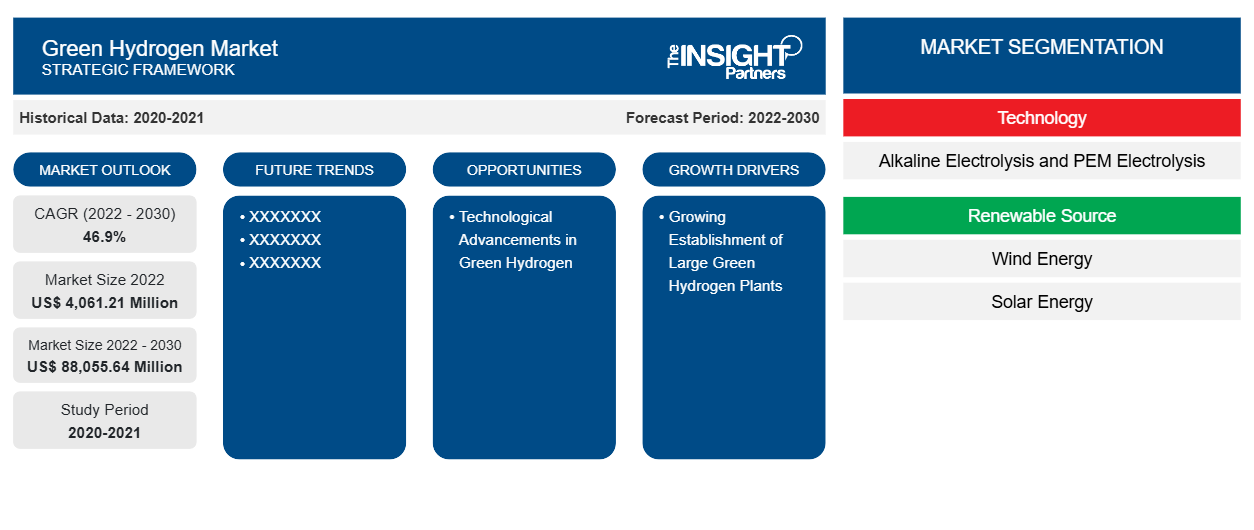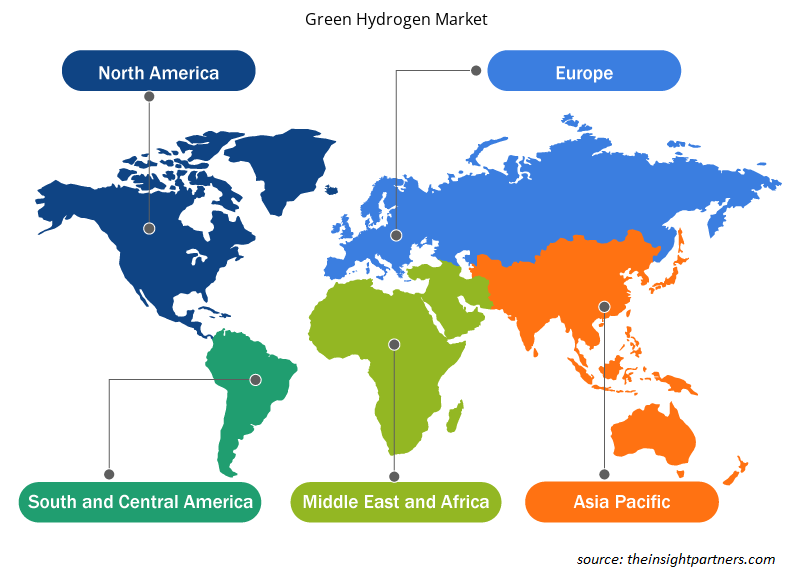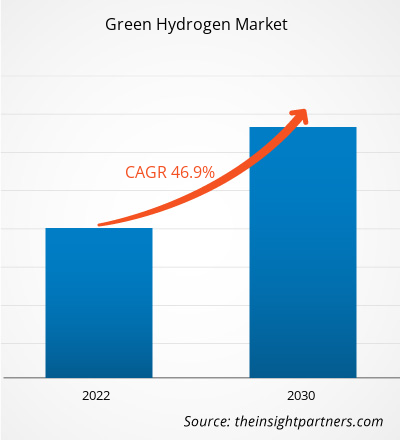Si prevede che il mercato dell'idrogeno verde crescerà da 8,38 miliardi di dollari nel 2024 a 71,31 miliardi di dollari entro il 2031; si stima che registrerà un CAGR del 37,8% dal 2025 al 2031. È probabile che la crescita significativa degli investimenti governativi nelle energie rinnovabili rimanga una tendenza chiave del mercato dell'idrogeno verde.
Analisi del mercato dell'idrogeno verde
I governi di tutto il mondo stanno riconoscendo i vantaggi dell'idrogeno verde come soluzione energetica pulita e sostenibile. Stanno adottando misure proattive per sostenerne lo sviluppo e l'implementazione in diversi settori. La crescente attenzione alla decarbonizzazione e alla mitigazione dei cambiamenti climatici sta spingendo i governi a dare priorità agli investimenti nell'idrogeno verde come mezzo per ridurre le emissioni di carbonio. Ad esempio, nel giugno 2022, Protium, una delle principali aziende produttrici di energia a idrogeno verde nel Regno Unito, ha fornito soluzioni energetiche end-to-end a zero emissioni nette. Pertanto, si prevede che l'aumento degli investimenti in progetti di idrogeno verde creerà valide opportunità di espansione del mercato nei prossimi anni.
Panoramica del mercato dell'idrogeno verde
L'elettrolisi viene utilizzata per produrre idrogeno verde separando le molecole d'acqua in ossigeno e idrogeno utilizzando l'elettricità. I progressi tecnologici nell'elettrolisi contribuiscono a migliorare l'efficienza, la convenienza e la scalabilità della produzione, dello stoccaggio e dell'utilizzo dell'idrogeno verde. Design degli elettrolizzatori migliorati, materiali catalizzatori avanzati e condizioni operative ottimizzate sono alcuni fattori che potrebbero portare a maggiori efficienze di conversione energetica, tempi di risposta più brevi e una maggiore durata delle apparecchiature. Nel luglio 2023, il Korea Research Institute of Standards & Science (KRISS) ha presentato una potenziale soluzione per la procedura di trasporto del vettore, durevole ed efficiente, di un fotoanodo con una pellicola protettiva per sviluppare la produzione di idrogeno verde. Tali progressi stanno anche ampliando la gamma di applicazioni dell'idrogeno verde. Pertanto, si prevede che i progressi tecnologici associati all'idrogeno verde alimenteranno la crescita del mercato durante il periodo di previsione.
Personalizza questo report in base alle tue esigenze
Riceverai la personalizzazione gratuita di qualsiasi report, incluse parti di questo report, analisi a livello nazionale, pacchetto dati Excel e potrai usufruire di fantastiche offerte e sconti per start-up e università.
Mercato dell'idrogeno verde: approfondimenti strategici

-
Scopri le principali tendenze di mercato di questo rapporto.Questo campione GRATUITO includerà analisi di dati che spaziano dalle tendenze di mercato alle stime e alle previsioni.
Driver e opportunità del mercato dell'idrogeno verde
La crescente domanda di FCEV favorirà il mercato
I veicoli elettrici a celle a combustibile (FCEV) utilizzano l'idrogeno come combustibile e impiegano le celle a combustibile per produrre elettricità, offrendo un'alternativa pulita e competente ai tradizionali veicoli con motore a combustione interna. Con i paesi impegnati a ridurre le emissioni di carbonio e a passare a trasporti a basse emissioni di carbonio , la domanda di FCEV è in aumento in tutto il mondo. Di conseguenza, diversi attori del mercato sono coinvolti in sviluppi strategici, come partnership, collaborazioni e accordi, per migliorare la propria offerta di prodotti e soddisfare la crescente domanda di FCEV. L'adozione di FCEV determina la necessità di produrre idrogeno verde, poiché rappresenta la principale fonte di carburante per questi veicoli.FCEVs) use hydrogen as a fuel and employ fuel cells to produce electricity, offering a clean and competent alternative to traditional internal combustion engine vehicles. With countries striving to reduce carbon emissions and transition to FCEVs is increasing across the globe. As a result, various market players are involved in strategic development, such as partnerships, collaborations, and agreements, to enhance their product offerings and fulfil the growing demand for FCEVs. The adoption of FCEVs drives the need for green hydrogen production, as it is the primary source of fuel in these vehicles.
Crescente presenza di grandi impianti di idrogeno verde: un'opportunità nel mercato dell'idrogeno verde
La realizzazione di impianti di idrogeno verde su larga scala attrae investimenti significativi sia dal settore pubblico che da quello privato. Nel giugno 2023, un gruppo di aziende ha annunciato il suo piano di investire 79,75 dollari USA in un progetto per l'ampliamento di un impianto di produzione di idrogeno e di un impianto di liquefazione dell'idrogeno nel Queensland, in Australia. Il gruppo di aziende comprende Kansai Electric Power Company (Giappone), Marubeni Corporation (Giappone), Iwatani Corporation (Giappone), Keppel Infrastructure (Singapore) e Stanwell Corporation (Australia). Si prevede che l'aumento dello sviluppo infrastrutturale creerà un ambiente positivo per l'implementazione dell'idrogeno verde in diversi settori, il che probabilmente offrirà prospettive di crescita agli operatori del mercato durante il periodo di previsione.Kansai Electric Power Company (Japan), Marubeni Corporation (Japan), Iwatani Corporation (Japan), Keppel Infrastructure (Singapore), and Stanwell Corporation (Australia). The rise in infrastructure development is expected to create a positive environment for the implementation of green hydrogen in different sectors, which is likely to offer growth prospects to the market players during the forecast period.
Analisi della segmentazione del rapporto sul mercato dell'idrogeno verde
I segmenti chiave che hanno contribuito alla derivazione dell'analisi di mercato dell'idrogeno verde sono la tecnologia, le fonti rinnovabili e l'uso finale.
- In base alla tecnologia, il mercato dell'idrogeno verde è stato suddiviso in elettrolisi alcalina ed elettrolisi PEM. Il segmento dell'elettrolisi alcalina ha detenuto una quota di mercato maggiore nel 2022.
- In termini di fonti rinnovabili, il mercato è stato segmentato in energia eolica, solare e altre. Il segmento dell'energia solare ha dominato il mercato nel 2022.
- In termini di settore di utilizzo finale, il mercato è stato segmentato in settori quali chimica, energia, alimentare e delle bevande, medicale, petrolchimica e altri. Il segmento energetico ha dominato il mercato nel 2022.
Analisi della quota di mercato dell'idrogeno verde per area geografica
L'ambito geografico del rapporto sul mercato dell'idrogeno verde è suddiviso principalmente in cinque regioni: Nord America, Asia Pacifico, Europa, Medio Oriente e Africa e Sud America/Sud e Centro America.
L'Europa è leader nel mercato dell'idrogeno verde. Diversi paesi europei, tra cui Spagna, Francia, Germania e Portogallo, hanno adottato misure per cooperare e costruire un gasdotto per l'idrogeno entro il 2030. Questo gasdotto faciliterà il trasporto di circa 2 milioni di tonnellate di idrogeno all'anno da questi paesi alla Francia. Mentre l'Europa cerca di garantire il proprio approvvigionamento energetico e accelerare la transizione verso un futuro a zero emissioni di carbonio, l'idrogeno verde emerge come una risorsa vitale e una soluzione chiave per ridurre la dipendenza dai combustibili fossili e raggiungere ambiziosi obiettivi climatici. Germania, Francia, Italia e Regno Unito sono alcuni dei principali paesi che operano nel mercato dell'idrogeno verde in Europa. Il governo tedesco ha già adottato misure per promuovere l'economia dell'idrogeno, tra cui l'adozione di una strategia nazionale per l'idrogeno. Ad esempio, nel marzo 2022, la Germania ha annunciato un contributo di 572 milioni di dollari per una nuova economia globale dell'idrogeno verde. Si tratta di un passo significativo nella promozione dell'adozione e dello sviluppo di soluzioni energetiche pulite in tutto il mondo.
Approfondimenti regionali sul mercato dell'idrogeno verde
Le tendenze e i fattori regionali che influenzano il mercato dell'idrogeno verde durante il periodo di previsione sono stati ampiamente spiegati dagli analisti di Insight Partners. Questa sezione illustra anche i segmenti e la geografia del mercato dell'idrogeno verde in Nord America, Europa, Asia-Pacifico, Medio Oriente e Africa, e Sud e Centro America.

- Ottieni i dati specifici regionali per il mercato dell'idrogeno verde
Ambito del rapporto sul mercato dell'idrogeno verde
| Attributo del report | Dettagli |
|---|---|
| Dimensioni del mercato nel 2024 | 8,38 miliardi di dollari USA |
| Dimensioni del mercato entro il 2031 | 71,31 miliardi di dollari USA |
| CAGR globale (2025-2031) | 37,8% |
| Dati storici | 2021-2023 |
| Periodo di previsione | 2025-2031 |
| Segmenti coperti |
Per tecnologia
|
| Regioni e paesi coperti |
America del Nord
|
| Leader di mercato e profili aziendali chiave |
|
Densità degli operatori del mercato dell'idrogeno verde: comprendere il suo impatto sulle dinamiche aziendali
Il mercato dell'idrogeno verde è in rapida crescita, trainato dalla crescente domanda degli utenti finali, dovuta a fattori quali l'evoluzione delle preferenze dei consumatori, i progressi tecnologici e una maggiore consapevolezza dei benefici del prodotto. Con l'aumento della domanda, le aziende stanno ampliando la propria offerta, innovando per soddisfare le esigenze dei consumatori e sfruttando le tendenze emergenti, alimentando ulteriormente la crescita del mercato.
La densità degli operatori di mercato si riferisce alla distribuzione delle imprese che operano in un determinato mercato o settore. Indica quanti concorrenti (operatori di mercato) sono presenti in un determinato spazio di mercato in relazione alle sue dimensioni o al suo valore totale.
Le principali aziende che operano nel mercato dell'idrogeno verde sono:
- Air Liquide
- Siemens Energia
- Cummins Inc.
- Linde Plc
- NEL ASA
- ?rsted A/S
Disclaimer : le aziende elencate sopra non sono classificate secondo alcun ordine particolare.

- Ottieni una panoramica dei principali attori del mercato dell'idrogeno verde
Notizie e sviluppi recenti sul mercato dell'idrogeno verde
Il mercato dell'idrogeno verde viene valutato raccogliendo dati qualitativi e quantitativi a seguito di ricerche primarie e secondarie, che includono importanti pubblicazioni aziendali, dati di associazioni e database. Di seguito è riportato un elenco degli sviluppi del mercato in termini di innovazione, espansione aziendale e strategie:
- Nell'ottobre 2022, NTPC e Siemens Ltd hanno firmato un Memorandum d'Intesa (MoU) per la fattibilità di dimostrare la co-combustione di idrogeno miscelato con gas naturale nelle turbine a gas Siemens V94.2 installate presso la centrale elettrica a gas di NTPC Faridabad. (Fonte: Siemens Ltd, Comunicato Stampa/Sito Web Aziendale/Newsletter)
- Nel dicembre 2022, Cummins Inc. ha fornito un sistema elettrolizzatore a membrana a scambio protonico (PEM) da 35 megawatt (MW) per il nuovo impianto di produzione di idrogeno di Linde a Niagara Falls, New York. (Fonte: Cummins Inc, Comunicato stampa/Sito web aziendale/Newsletter)
Copertura e risultati del rapporto sul mercato dell'idrogeno verde
Il rapporto “Dimensioni e previsioni del mercato dell’idrogeno verde (2020-2030)” fornisce un’analisi dettagliata del mercato che copre le seguenti aree:
- Dimensioni e previsioni del mercato dell'idrogeno verde a livello globale, regionale e nazionale per tutti i principali segmenti di mercato coperti dall'ambito
- Dinamiche di mercato come fattori trainanti, vincoli e opportunità chiave
- Tendenze del mercato dell'idrogeno verde
- Analisi PEST e SWOT dettagliate
- Analisi del mercato dell'idrogeno verde che copre le principali tendenze del mercato, il quadro globale e regionale, i principali attori, le normative e i recenti sviluppi del mercato
- Analisi del settore, del panorama e della concorrenza del mercato dell'idrogeno verde, che copre la concentrazione del mercato, l'analisi della mappa di calore, i principali attori e gli sviluppi recenti
- Profili aziendali dettagliati
- Analisi storica (2 anni), anno base, previsione (7 anni) con CAGR
- Analisi PEST e SWOT
- Valore/volume delle dimensioni del mercato - Globale, Regionale, Nazionale
- Industria e panorama competitivo
- Set di dati Excel
Report recenti
Testimonianze
Motivo dell'acquisto
- Processo decisionale informato
- Comprensione delle dinamiche di mercato
- Analisi competitiva
- Analisi dei clienti
- Previsioni di mercato
- Mitigazione del rischio
- Pianificazione strategica
- Giustificazione degli investimenti
- Identificazione dei mercati emergenti
- Miglioramento delle strategie di marketing
- Aumento dell'efficienza operativa
- Allineamento alle tendenze normative






















 Ottieni un campione gratuito per - Mercato dell'idrogeno verde
Ottieni un campione gratuito per - Mercato dell'idrogeno verde